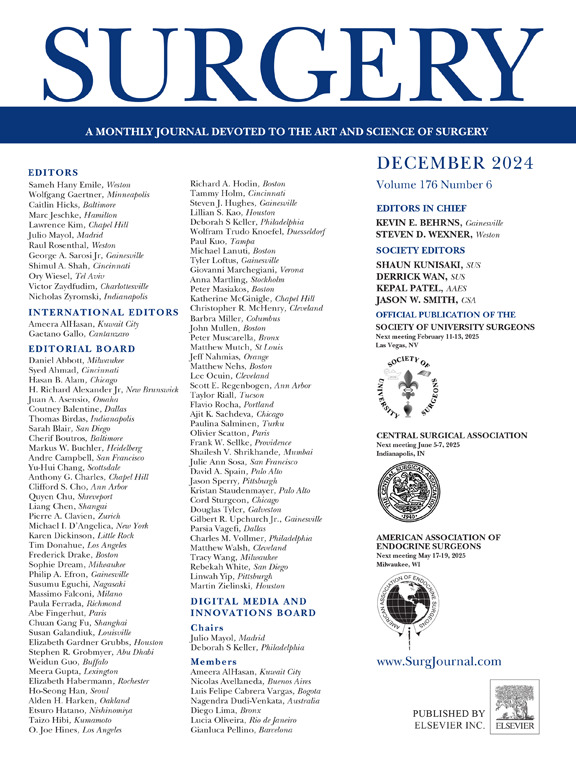基于解剖标志的腹腔镜中央胰切除术109例的分类分析
IF 3.2
2区 医学
Q1 SURGERY
引用次数: 0
摘要
背景腹腔镜下中央胰腺切除术(LCP)通常被推荐用于非恶性颈-体肿瘤,但也可以推荐用于头颈部病变以避免胰十二指肠切除术,或用于体-尾病变以避免远端胰腺切除术。本研究的目的是根据近端切除程度对CP进行分类。方法回顾性分析我院2011年至2024年连续行LCPs的病例。LCP可与血管手术(胃十二指肠动脉或脾血管)有关,并根据胰腺近端切除程度分为3种类型:头-LCP、颈-LCP和体-LCP(结果按此顺序)。本研究的主要目的是创建和定义LCP的新分类。次要目的是比较结局和教科书结局(TBO)完成情况,TBO的定义是在术后90天内无临床相关的术后胰瘘,无临床相关的胰切除术后出血,无胆汁漏,无再入院,无死亡率,无严重发病率。结果109例患者行LCP,其中头部LCP占20%,颈部LCP占66%,全身LCP占14%。病变类型与胃十二指肠动脉距离相关(P = 0.0001)。头部和身体lcp更常与血管手术相关(68% vs 17% vs 40%, P = .001),与头部和颈部lcp相比,身体lcp与更大的肿瘤大小(毫米)相关(17 vs 21 vs 35, P = .07)。TBO无显著差异(41% vs 58% vs 47%, P = 0.31), 1例患者死亡(死亡率<;1%)。在中位随访(22个月)时,新发外分泌率(6%;P = 0.10)或内分泌(4%;P = 0.76)胰腺功能不全相似。在多因素分析中,只有美国麻醉学会评分≥2分(P = 0.03)和胰腺质地(P = 0.01)是TBO的预后因素,而LCP类型与TBO无关。结论:在不影响TBO的情况下,通过相关血管手术评估,头部和颈部lcps更具挑战性,允许一些选定的患者进行保留实质的手术。需要进一步的研究比较CP与标准胰腺切除术。本文章由计算机程序翻译,如有差异,请以英文原文为准。
A classification of laparoscopic central pancreatectomy determined on the basis of anatomical landmarks in 109 patients
Background
Laparoscopic central pancreatectomy (LCP) is usually proposed for non-malignant neck-body neoplasms, but it can be proposed for head-neck lesions to avoid pancreaticoduodenectomy or for body-tail lesions to avoid distal pancreatectomy. The aim of this study was to classify CP on the basis of the proximal resection level.
Method
We retrospectively studied all consecutive LCPs performed in our institution from 2011 to 2024. LCP can be associated with vascular procedures (gastroduodenal artery or splenic vessels) and was classified into 3 types according to proximal level of pancreatic resection: head-LCP, neck-LCP, and body-LCP (results in this order). The primary objective of this study was the creation and definition of this new classification for LCP. The secondary objectives were to compare outcomes and textbook outcome (TBO) completion, defined as no clinically relevant postoperative pancreatic fistula, no clinically relevant postpancreatectomy hemorrhage, no bile leaks, no readmission, no mortality, and no severe morbidity within 90 postoperative days.
Results
In total, 109 patients underwent LCP with head-LCP, neck-LCP, and body-LCP observed in 20%, 66%, and 14%, respectively. The type was correlated with the distance of the lesion from the gastroduodenal artery (P = .0001). Head and body-LCPs were more frequently associated with vascular procedures (68% vs 17% vs 40%, P = .001) and body-LCP was associated with larger tumor size (millimeters) compared with head and neck-LCPs (17 vs 21 vs 35, P = .07). TBO did not differ significantly (41% vs 58% vs 47%, P = .31) with one patient death (mortality <1%). At median follow-up (22 months), the rate of new-onset exocrine (6%; P = .10) or endocrine (4%; P = .76) pancreatic insufficiencies was similar. On multivariate analysis, only American Society of Anesthesiologists score ≥2 (P = .03) and pancreatic texture (P = .01) were prognostic factors for TBO while LCP type was not.
Conclusion
Head and neck-LCPs were more challenging as assessed by the associated vascular procedures without impact on TBO, allowing in some selected patients parenchymal-sparing surgery. Further studies comparing CP with standard pancreatic resections are needed.
求助全文
通过发布文献求助,成功后即可免费获取论文全文。
去求助
来源期刊

Surgery
医学-外科
CiteScore
5.40
自引率
5.30%
发文量
687
审稿时长
64 days
期刊介绍:
For 66 years, Surgery has published practical, authoritative information about procedures, clinical advances, and major trends shaping general surgery. Each issue features original scientific contributions and clinical reports. Peer-reviewed articles cover topics in oncology, trauma, gastrointestinal, vascular, and transplantation surgery. The journal also publishes papers from the meetings of its sponsoring societies, the Society of University Surgeons, the Central Surgical Association, and the American Association of Endocrine Surgeons.
 求助内容:
求助内容: 应助结果提醒方式:
应助结果提醒方式:


